Letters from Lodi
An insightful and objective look at viticulture and winemaking from the Lodi
Appellation and the growers and vintners behind these crafts. Told from the
perspective of multi-award winning wine journalist, Randy Caparoso.
Four 2018 wine grape lessons (part 1)
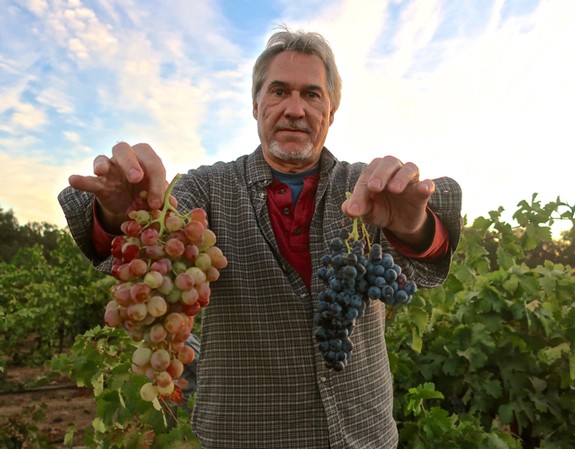
Lodi's 2018 heirloom Flame Tokay and Zinfandel harvest in Jessie's Grove's 129-year-old Royal Tee Vineyard
The months of August, September and October are the climatic peaks of each growing season in Lodi wine country, as they are in all the wine regions of the Northern Hemisphere. These are the months when wine grapes reach full maturation, thus ready for harvest. It is also the time of year when we rush out into the vineyards to poke, prod, taste and photograph the grapes just before or during peak ripeness. And this is how we learn more about exactly how the individual characteristics of each variety are impacted by factors such as terroir (the French word for "sense of place," determined by vineyard location), grower and winemaker decisions, and above all, the whims of Mother Nature (i.e. peculiarities of each "vintage").
All the fine wines of the world are defined mostly by the grapes that go into them. It is why, for instance, white wines made from the Albariño grape are almost always lighter, sharper, more flowery, citrusy and flinty than white wines made from Chardonnay. Yet an Albariño grown in its native Rías Baixas, Spain is not exactly the same as an Albariño grown in Lodi. Why should it be? Rías Baixas is over 5,600 miles - an entire continent and ocean - away from Lodi. The climate, weather, soils and topography are different. Viticultural and winemaking traditions, and actual practices, are a little different. Wine is consumed in different culinary and social contexts, and so perception of quality is different. Sure, there are similarities, since Lodi and Rías Baixas are both part of a growing global community; but all the little things add up, impacting wine grape morphology and, ultimately, the way wines taste.
By the same token, a Chardonnay grown in Lodi tends to be softer and more fruit-forward than a Chardonnay grown just 80 miles away in Sonoma Coast; and Sonoma Coast and Lodi Chardonnays are even more different from the higher elevation, minerally structured Chardonnays grown in Santa Cruz Mountains, the lean and tart-edged Chardonnays of Oregon's colder climate Willamette Valley, the pungently tropical Chardonnays of sun soaked South Australia, or (especially) the crisply balanced, multi-faceted Chardonnays of France's Burgundy region, where the grape originated and thus is more naturally adapted.
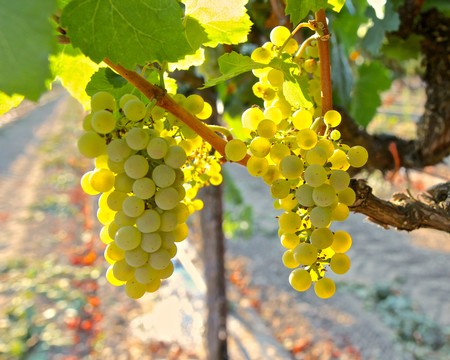
Lush and fruit-forward Chardonnay grown in Lodi
Ergo: Terroir often trumps the grape associated characteristics expected in each varietal wine, and it all starts with how grapes respond to their respective environments.
The fascinating thing is that even within any given region such as Lodi, Sonoma Coast or Burgundy, you can find dramatic variations in grape cluster size, weight, berry shapes, aromas and sensations depending upon each vineyard location - all ultimately effecting how wines turn out, even when made from the exact same grape or clonal selection of that grape.
During Lodi's 2018 harvest season, we posted eight consecutive blogs on wine grapes utilizing photos and winegrower comments to demonstrate the differences between varieties and vineyards; all worth an abbreviated recap (which we are doing in two parts) for posterity's sake. So here we go...
Bokisch Vineyards' Terra Alta, Las Cerezas and Andrus vineyards Albariño
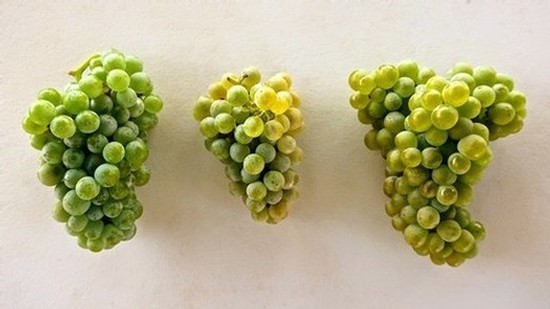
Bokisch Ranches Albariño from 1) Las Cerezas Vineyard (Mokelumne River-Lodi AVA); 2) Terra Alta Vineyard (Clements Hills-Lodi AVA); 3) Andrus Vineyard (Sacramento County, west of Lodi AVA)
In our August 21, 2018 post entitled Bokisch Vineyards demonstrates impact of terroir on grapes, Bokisch Vineyards owner/grower Markus Bokisch broke down the graphic differences in cluster sizes and even color (photo above), leading to distinctive differences in resulting wines, in three of his Albariño plantings:
“First of all,” says Mr. Bokisch, “the size, or cluster architecture, of the Albariño grape no matter where it’s grown – whether in California or Spain – tends to be very small, similar to a Pinot gris. It looks like a little hand grenade, and there is usually no wing (i.e. secondary arm growing from the top part of the main cluster) associated with it. If there is a wing, it is typically very small.
“Albariño clusters tend to be medium-tight, with a visibly thick cuticle. The cuticle is the grayish, waxy film visible on the skin, or epidermal cells, of each berry. Grapes with visible layers of cuticle usually have the highest degree of tolerance for mildew, compared to other varieties. Which makes sense, because if you see where Albariño originated, in Spain’s Galicia region (particularly the Rías Baixas), 50 inches of rain is not atypical. Therefore, a fair amount of mildew tolerance in a variety grown in that area makes sense. Any mildew-prone variety typically does not do well there.
“The other thing you see is that berries in the cluster tend to be on the smaller side. This allows for even a compact cluster to have more gaps or spaces between each berry, allowing for more airflow and, as a result, adds to the mildew-resistance.

Markus and Liz Bokisch with their Terra Alta Vineyard (Clements Hills-Lodi AVA) Albariño harvest
“The major distinction between the Albariño clusters coming from Las Cerezas on the left, Terra Alta in the middle, and Andrus Island on the right is a size differential based on location. The Terra Alta cluster is the smallest because it is grown in the most nutrient-depleted soils (a Redding Series gravelly clay loam), here at our winery and tasting room location in Clements Hills (AVA). Therefore the total capacity or vigor of the vine is diminished. The clusters are smaller, and you also have a yellower color in the berries, which is related to sun exposure. In an area where the soils are more depleted, not only are the berries and clusters smaller, but the canopies (i.e. shoot and leaf growth) are also smaller, allowing for more light infiltration.
“What you see in Las Cerezas Albariño on the left is a reflection of the silty or sandy (Tokay Series) loams found in the Mokelumne River AVA. Here the soils have a low to moderate nutrient regime, thus a little more vigor; plus better water-holding capacity than in Clements Hills. It is still a typically compact size as Albariño clusters go; only, but slightly larger, on average, than what we get in Terra Alta Vineyard.
“When you get to the Andrus Vineyard in Sacramento County, located on Andrus Island (in the Sacramento-San Joaquin Valley River Delta), now you’re talking about a vineyard site that needs no irrigation all season long. It’s dry farmed – doesn’t need a drop of water – because the area has a high water table, giving the plants all the water they need. These are also peat loamy soils (primarily in the Ryde Series), notably richer in natural nutrients. As a result, Andrus Vineyard is one of our most challenging sites in terms of slowing down plant vigor.
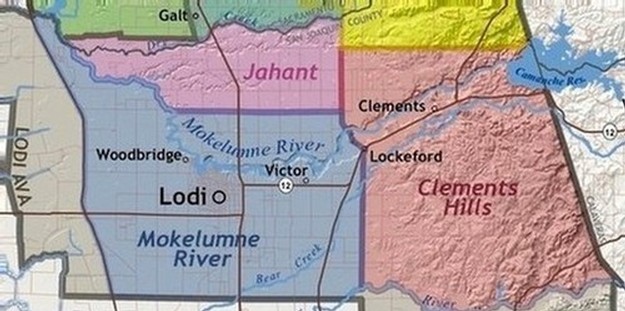
Map showing the Lodi sub-appellations (American Viticultural Areas, a.k.a. AVAs) of Mokelumne River and Clements Hills
“Consequently, some of that vigor gets taken out in the cluster, creating what would be a larger than average Albariño cluster. It actually has the emergence of a small wing, which is really odd for the variety. The berries are on average bigger that what you see in Terra Alta or Las Cerezas, and the color also tends to have a little more green.”
In regards to the sensory ramifications of these variable clusters of Albariño, Bokisch Vineyards winemaker Elyse Egan Perry tells us:
“In Las Cerezas, we tend to get a little more floral aromatics, as opposed to the little more citrus qualities we get in both the Terra Alta and the Andrus Albarinos. In the Terra Alta, you’re getting more citrus notes on the palate – more tangerine, lemon zest, and a little more of that saline quality on the palate. While not super-strong, this brininess is there, perhaps a little more on the finish of the wine than anywhere else.
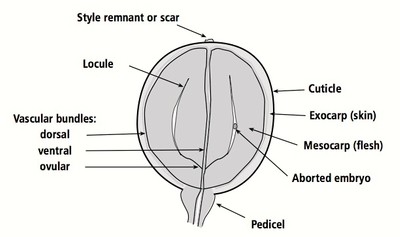
Wine grape vocabulary
“Of all our Albariños, the Andrus fruit tends to be a little bit more on the tropical side, with pronounced melon, although it also holds its acid really well. As the sugars rise, the acids don’t drop out as much as they do in the other two. Which is why I usually pick Andrus Vineyard at around 22° Brix (i.e. sugar reading), whereas Terra Alta and Las Cerezas are picked at lower sugars, closer to 21°, 21.5°.
“The vineyards also ripen differently. The Terra Alta is the first to come into the winery; the soils in Clements Hills being the oldest and most nutrient-depleted out of the three. When vines struggle, fruit ripens sooner. When you go west to Las Cerezas, in the silty-sandy soils of the Mokelumne River, these are the second Albariños to come in; and then Andrus, growing in the youngest, peaty soils, is usually a couple weeks behind those two, the highest yielding vineyards being the slowest to ripen.”
Jessie's Grove's Royal Tee Vineyard ancient vine Zinfandel field mix
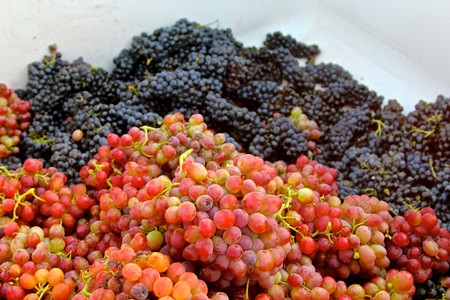
Royal Tee Vineyard Flame Tokay and Zinfandel grapes picked together for Alquimista Cellars' 2018 harvest
In our August 28, 2018 post entitled Lodi's oldest, most historic Zinfandel planting, the subject was Jessie’s Grove Winery’s Royal Tee Vineyard: a venerated block planted in the (Tokay Series) fine sandy loam of Mokelumne River’s west side, on its own (Zinfandel) rootstocks, by Joseph Spenker in 1889. The vineyard is a remnant of a larger planting, originally planted between 1886 and 1889, that once topped 45 acres. What remains is precisely 4.95 acres.
The peculiar thing about the Royal Tee – at least for Lodi – is that only about 84.5% of the vineyard consists of Zinfandel plants (the vast majority of Zinfandel blocks in Lodi are 100% Zinfandel, if not at least 98% or 99% of the grape). The rest of Royal Tee is Carignan (about 10.5%), Flame Tokay (4%), Mission (.5%) and a rare, 19th century heirloom called Black Prince (.5%).
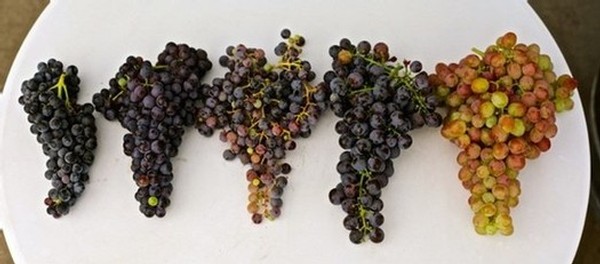
Royal Tee Vineyard grapes (from left): 1) Zinfandel; 2) Carignan; 3) Mission; 4) Black Prince; 5) Flame Tokay
Plucking cluster samples of each variety for us to examine, Jessie's Grove owner/grower/winemaker Greg Burns explained: “You can see and taste the unique character of each grape. Zinfandel produces the smallest berries and cluster; and even though it is not yet completely ripe (in mid-August 2018), you can already taste the jammy berry flavor and tannin structure that makes it such a beautiful wine.
“Carignan, on the other hand, is a larger cluster with medium sized berries. The taste is more like sour cherry. You can clearly see why Carignan was blended with Zinfandel – to give it that acidity, especially since Carignan ripens later than Zinfandel.
“Mission also ripens later than Zinfandel, and is a long, very loose cluster of smaller berries. Its fruit is very soft tasting, and by itself, it would make a juicy, easy drinking wine with just a little tartness. But it can never be a very complex wine, which is why the old timers always preferred Zinfandel as the predominant grape.
“Finally, the Black Prince and Flame Tokay grapes, which have a table grape quality – big, generous clusters with soft fruit, crunchy seeds, big berries, great for eating. Before we started producing our Ancient Vine Tokay (a lightly fortified style of sweet dessert wine), we used to leave the Tokay out in the field for our workers to eat; which, of course, was why this grape was grown for so many years in Lodi, as a table product.
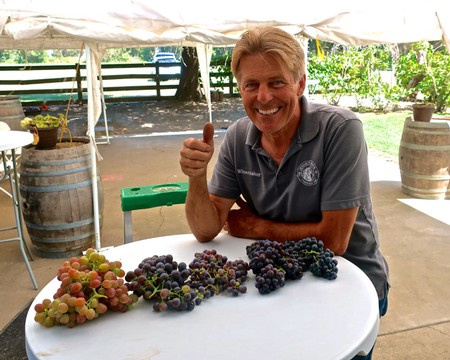
Jessie's Grove's Greg Burns with 2018 Royal Tee Vineyard cluster samples
“I think that back in 1889 winemakers intuitively knew that if you plant Zinfandel in a field mix you can get a fuller range of flavor profiles in a wine. Greg La Follette (winemaker/partner of Alquimista Cellars) has been making wine from all five varieties since 2015 (see our notes (and Mr. La Follette's remarks) on the 2017 Alquimista Jessie's Grove Vineyard Zinfandel here). I think Greg has proven that fermenting all five grapes together in their original proportions brings out the best in the vineyard.
“For Jessie’s Grove, we’ve been separating the Zinfandel out from the rest to produce our Royal Tee Vineyard Zinfandel. The Carignan has been going into our Ancient Vine Carignane bottlings, and our Tokay, of course, goes into our Ancient Vine Tokay. Last year (in 2017) I picked my own field blend for the first time, and it is a softer yet more complex wine; every bit as rich as our 100% Zinfandel, but different, as you would expect.”
The white wine Rhône Valley grapes of Acquiesce estate
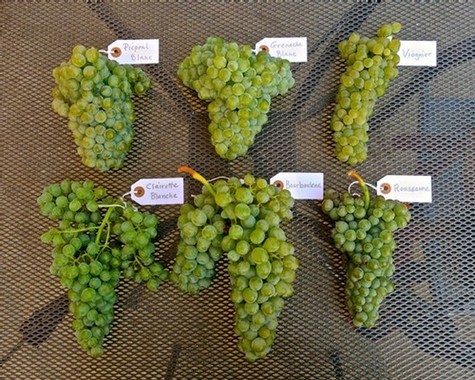
Acquiesce grown white wine grapes: (top, from left) Piquepoul, Grenache blanc and Viognier; (bottom, from left) Clairette blanche, Bourboulenc and Roussanne)
In our September 5, 2018 post entitled The utterly unique white Rhône grapes of Acquiesce Vineyards, Acquiesce Winery owner/grower/winemaker Sue Tipton commented on the six white wine grapes she grows to produce her enormously popular, 100% estate grown, zero-oak influenced Acquiesce label wines:
Piquepoul (a.k.a. Picpoul blanc) - “Our Picpoul Blanc is a real favorite in the tasting room. It’s traditionally meant to go with oysters and shellfish, but people love to drink it on its own. I think the most unique thing about Piquepoul here in Lodi is the fact that it has this fruit-forwardness that you don’t typically see in Piquepouls from, say, Southern France (particularly the Picpoul de Pinet appellation). I believe that’s due to Lodi. The fact that we’re able to take this grape to ripeness here, where we can get a nice pineapple essence in the grape even when picked at low sugars – around 20° Brix (i.e. sugar reading), which usually finishes at around 12.5% alcohol – all goes to show how unique Lodi really is as a winegrowing region.
Grenache blanc - "Grenache blanc is the first white wine grape we planted in our vineyard in 2008, all on head trained vines. It’s because it did so well that we decided to plant the other white Rhône varieties. The cluster you see here comes from our original head trained vines. It’s a little smaller than the clusters we get on our trellised plantings, which we put in later; although in our vineyard.
"Grenache blanc is one of the most popular white wine grapes in Southern France; but over there, it is almost always part of a blend. We use it to produce a pure varietal; and it is also usually about 45% of my blend, the Acquiesce Belle Blanc (made from Grenache blanc, Roussanne and Viognier), which is our homage to Châteauneuf-du-Pape Blanc. We also use Grenache blanc as the base wine of our Champagne style sparkling wine, which is one-of-a-kind. We could be wrong, but I don’t believe there is any other sparkling wine in the world made from Grenache blanc.”

Comparison of Acquiesce Grenache blanc clusters grown on head trained vines (left) vs. trellised vines (right)
Viognier - "Our Viognier produce the smallest of our white wine clusters, which is typical, It is always triangular in shape, and fun in the vineyard because it doesn't have a tendency to overcrop, at least in our sandy soils (our note: Acquiesce is located at the northern edge of Lodi's Mokelumne River AVA, defined by its sandy Tokay Series soil)... Viognier is not one of the white wine grapes of Châteauneuf-du-Pape. It is grown further up the valley, in the Northern Rhône. All of my white Rhône grapes have their own unique flavor; but different, perhaps, than all the others, a Viognier grape tastes just like a wine made from Viognier. You can go out into the vineyard and taste the grapes, and it will be almost exactly what you get after you ferment it. The grapes have nice peach, apricot, tangerine flavors, with floral notes – particularly honeysuckle and violet.
“We make our Viognier fairly low in alcohol, relatively speaking. We pick right around 23° Brix, and our alcohols end up under 14%, taken all the way to dryness. A lot of American Viogniers, on the other hand, are finished with some residual sugar. Sometimes we find customers who say they don’t want to try ours because they’ve had Viogniers before that were sweet; either that, or high in alcohol or oaky. We get them to try ours, telling them that this might not be what they expect, and they love it. Of course, Viognier is such a floral wine, it can be perceived as sweet because of its nose."
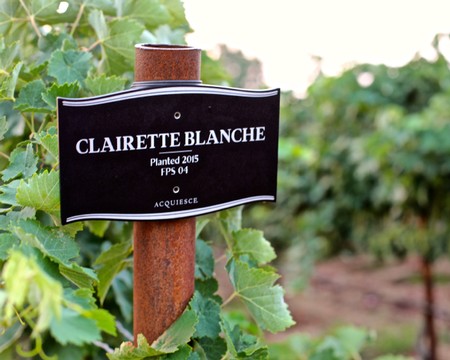
Clairette blanche - "The Clairette blanche cluster has a prominent shoulder, or wing; and rather round, the berries tend to have an ovoid shape to them, more pronounced in some years. As a varietal, this has been one of our biggest hits. It is, like, the best white wine I've ever had with cheese. With Clairette blanche you can really push the limit. We've tried blue cheeses, feta, goats, anything you can think of, they've all gone really well with this varietal, I think it has a bright crispness like a Sauvignon blanc and the green apple of a Grenache blanc, but it takes things further with its own other layer, which is almost like a caramel essence. It is not sweet; but when ripe, the grape itself tastes almost like a caramel-apple. I t hink it's this unique character that makes it so versatile with cheeses."
Bourboulenc - "You can see that Bourboulenc is just about our largest variety, as grape clusters go, with fairly large berries that give a nice, distinctive lemon/lime taste. Bourboulenc has been puzzling for most people – even those who really know their white wines – because it’s basically unlike anything anyone has tried before... Just since last fall we’ve had three Masters of Wines from the U.K. visiting us, and none of them were been able to share their thoughts because they’d never had a white wine made from 100% Bourboulenc either!"
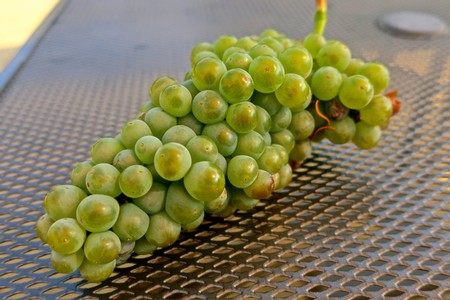
Close-up of russet-tinged Roussane grape from the Acquiesce estate
Roussanne - “Finally, we have the Roussanne, which the nurseries supposedly call ‘The Princess,’ because it can be a little demanding to grow, prone to a lot of problems. Roussanne comes from the word roux, in reference to the grape’s russet color. The grape cluster has a reddish-brown tinge. When Aaron Shinn (Round Valley Ranches vineyard manager) first started farming it, he came up to me and said, ‘Sue, there may be something wrong with the Roussanne, it’s changing into a weird color.’ I told him, ‘I think it’s supposed to do that – it’s Roussanne!’
“In some ways, Roussanne is my favorite of the Rhône grapes. It has this honeyed/almond characteristic; and when it’s a little older, it develops this rich marzipan texture and flavor... Most of our wine club members might prefer the super-young Acquiesce varietals for all their brightness of fruit. But for Roussanne, I lean more towards the taste of a mature wine. This is the last of the varietal bottlings that we release each year – it comes out even after the Belle Blanc. If we didn’t sell out of all of the wines so quickly, I’d hold our Roussanne back even longer; at least a year after all the rest, because it’s really in about its third year that a Roussanne really starts to express itself..."
Three German grapes finding a "secret place" in Markus Wine Co. Nativo

Markus Wine Co. Nativo label
From our September 13, 2018 post entitled Markus Wine Co.'s Markus Niggli approaches grapes like colors on a palette:
To Markus Niggli, the owner/winemaker of Markus Wine Co., wine grapes are like paints on a palette. The purity of the colors selected by an artist are important enough; but it’s how the colors are put to canvas – the interplay, the blending, the contrasts and textures, and of course, the arresting skill and imagination – that catches the eye, stimulates the mind, and even riles the senses or emotions, consciously or unconsciously.
And so, unlike your typical American winemaker (or perhaps because he is European-born), Mr. Niggli is less satisfied with interpretations of “varietal” wine – wines made primarily from one grape – than he is with creating blends from different grapes. Therefore, when you taste a Markus Wine Co. wine you are experiencing one winemaker’s thought process, or a culmination of his past experiences. Like an artist’s colors, grapes contribute to characteristics, as do sense of place, or terroir (in Niggli’s case, grapes that are very much “Lodi” grown). But in the end, the sum means more than the parts.

Rare (for the U.S.), typically small clustered Bacchus grapes in Mokelumne Glen Vineyards
Take, for example, the Markus Wine Co. “Nativo”: Niggli’s wily blend of Kerner (a German Trollinger x Riesling crossing), Riesling and Bacchus ({Silvaner x Riesling} x Müller-Thurgau {Riesling x Madeleine Royale}). On a sensory level, the wine is light, airy, minerally in its dryness, sensual in feel, and provocatively scented – like whiffs of lemon and glowing skin on the wrist of a proverbial maiden. This is what happens when focus is shifted away from single “varietals.”
Mr. Niggli packages his Nativo white under a lime-green label with an abstraction of the postal code of his hometown in Weesen, Switzerland, along with the initials of Markus and his brothers, Konrad and Bernhard. Like the grapes, the vineyard source – Mokelumne Glen Vineyards, tucked into a riverbend on the east side of Lodi’s Mokelumne River Viticultural Area – is an important factor, but so is the winemaker’s sensibility. Whether or not the art label “says” exactly what he is thinking or feeling, the wine itself finds a separate place, an almost secretive niche, different from that of any other wine made in the U.S., or the world for that matter: the unique "colors" of Nativo.
Late last month (August 2018) we asked Mr. Niggli to take us around to look at the various grapes and vineyard sources he uses as his “palette.” His comments on the Germanic white wine grapes sourced each year from Mokelumne Glen Vineyards:

From Mokelumne Glen Vineyards in Mokelumne River-Lodi (from left): 1) Kerner; 2) Bacchus; and 3) Riesling
Explains Niggli: “The Nativo is usually about 75% or 80% Kerner, which you see on the left. Kerner is a German crossing, but is as distinctive as any other grape, with its own character. It is also distinctive in the vineyard. It is an average sized grape cluster; nice and loose, with medium sized berries which always have a little ‘dot’ on them from where the flower pops off during the spring fruit set. It is a grape that seems to do very well in Lodi.
“Bacchus, which you see in the middle, is usually a small, tight cluster with lots of gray specks. It also seems to produce very interesting wine in Lodi, but is very slow to ripen, usually several weeks after Kerner. Some years it barely ripens at all, which is aggravating; but it makes a wine with great acid, a robust flavor, yet very refreshing.
“Riesling is Riesling – it is the classic grape of Germany, not what you expect to find growing in Lodi. It also brings very good acid to the wine, and lots of fragrance and flavor. In the Nativo, Kerner is responsible for the mouth-feel – light, fresh, flinty, playful. The Riesling provides a sense of sweetness in its fruit, but has better acid than the Kerner. Because it is not always completely ripened, the Bacchus from Mokelumne Glen usually ends up giving us even more acid backbone, adding to the overall balance of the blend."
Mr. Niggli's own tasting notes on his most recent vintage of Nativo (a 2016 which, alas, is sold out at the winery).
Please see Part 2 of Four 2018 Wine Grape Lessons
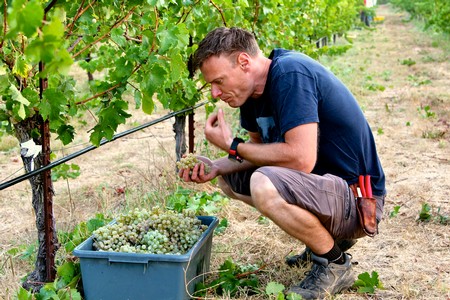
Markus Niggli sampling his Mokelumne Glen Vineyards Kerner harvest